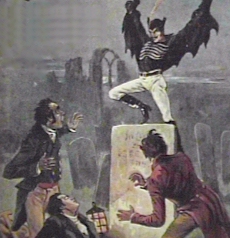
Spring Heeled Jack
A mysterious legend, that much like the other creatures made famous in the 19th century, Frankenstein, Dracula and the Wolf-man, seems to be based in a mixture of fact and fiction. He is called “Spring-Heeled Jack” and stories of this legend have filled newspapers on two continents for over two hundred years. Spring Heeled Jack made his first appearance in the Sheffield Times where it was accounted that he would scare local residents and play pranks within the city of Sheffield, a city in South Yorkshire, UK, then would bound away in enormous leaps.
Twenty years later, in the 1830’s, Spring Heeled Jack emerges again. This time in London, where he graduated to attacking two women, tearing one of the women’s clothing and causing scratches on her skin. It is during this year and a half long string of sightings that a description of the unusual creature emerges. He was described as wearing a tight oilskin suit with a helmet and a cape. He had long pointed ears, long pointed nose, and red glowing eyes. From his mouth, Jack would often spit a blue or white flame which would temporarily blind his victims as he leaped away.
In the late 1840’s, reports of attacks by Spring Heeled Jack began to emerge from all over the country. He was even blamed, in newspapers, for the death of a thirteen year old girl. The attacks would continue until the 1870’s. During this time, the creature became more emboldened and tales of him became more extravagant. Attacking in broad daylight and leaping over high fences and onto rooftops to escape from townspeople who hunted him or military personnel who attempted to pursue him became very common stories throughout England.

Spring Heeled Jack Poster
Finally, in 1880, Spring Heeled Jack made his first appearance in the United States when women in Louisville, Kentucky began to report that they had been attacked by a man-like creature wearing black, tight clothing and a cape. He could jump great heights and distances. The attacker had long pointed fingers, ears and nose and would spit a blue glowing flame from his mouth. Jacks presence in Louisville was short lived and he disappeared back into the legend world until his reappearance in Liverpool, England, in 1904. There the attacks began again by the same mysterious creature that would jump from rooftop to rooftops as he made his escape.
In 1938 Spring Heeled Jack made another U.S. appearance in Provincetown, Massachusetts. One resident of Provincetown claims to have shot the creature with a shotgun at which time Jack proceeded to laugh loudly then casually hop over an eight foot high fence and disappeared. Sightings and attacks on Cape Cod would continue until 1945. Then Spring Heeled Jack reappears in Houston, Texas, in 1953 where three residents saw what they thought was a man walking across their backyard. He was wearing tight black clothing and had, what appeared to them to be wings on his back. The figure leapt high into a tall tree, dropped back down and leapt off into the darkness.
The strange creature with pointed ears, red glowing eyes, tight black suit and leaps great heights and distances has continued to appear for the last sixty years. Sightings of Spring Heeled Jack have been reported in, Sidney, North Carolina in 1973, Plano, Texas in 1979, Sheffield and West Surry, England in 1986 and several unsupported sighting in 1995.
Who is Spring Heeled Jack?
StrangeHistory.org believes that Spring Heeled Jack is an urban legend begun in 1837, by, or because of, Lord Henry Beresford, the third Maquess of Waterford. That year a group of young aristocrats were blamed for the London incident, which was the first real account of Spring Heeled Jack. Among them, and probably the leader of the small group was Beresford. “The Mad Marqess”, as he was often called, had severe detestation for the police and women and had several run-ins with both. Twenty years after the death of Lord Henry Beresford, the author of Brewer's Dictionary of Phrase and Fable, E Cobham Brewer, said that Beresford "use to amuse himself by springing on travellers unawares, to frighten them, and from time to time others have followed his silly example". Although there is no definitive proof of Lord Henry Beresford’s roll in the story, it is widely believed that he is the reason for the legend of Spring Heeled Jack.
